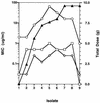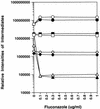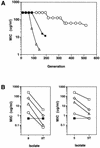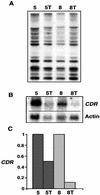Rapid, transient fluconazole resistance in Candida albicans is associated with increased mRNA levels of CDR
- PMID: 9756759
- PMCID: PMC105901
- DOI: 10.1128/AAC.42.10.2584
Rapid, transient fluconazole resistance in Candida albicans is associated with increased mRNA levels of CDR
Erratum in
- Antimicrob Agents Chemother 1999 Feb;43(2):438. Rustad T [corrected to Rustad TR]
Abstract
Fluconazole-resistant Candida albicans, a cause of recurrent oropharyngeal candidiasis in patients with human immunodeficiency virus infection, has recently emerged as a cause of candidiasis in patients receiving cancer chemotherapy and marrow transplantation (MT). In this study, we performed detailed molecular analyses of a series of C. albicans isolates from an MT patient who developed disseminated candidiasis caused by an azole-resistant strain 2 weeks after initiation of fluconazole prophylaxis (K. A. Marr, T. C. White, J. A. H. vanBurik, and R. A. Bowden, Clin. Infect. Dis. 25:908-910, 1997). DNA sequence analysis of the gene (ERG11) for the azole target enzyme, lanosterol demethylase, revealed no difference between sensitive and resistant isolates. A sterol biosynthesis assay revealed no difference in sterol intermediates between the sensitive and resistant isolates. Northern blotting, performed to quantify mRNA levels of genes encoding enzymes in the ergosterol biosynthesis pathway (ERG7, ERG9, and ERG11) and genes encoding efflux pumps (MDR1, ABC1, YCF, and CDR), revealed that azole resistance in this series is associated with increased mRNA levels for members of the ATP binding cassette (ABC) transporter superfamily, CDR genes. Serial growth of resistant isolates in azole-free media resulted in an increased susceptibility to azole drugs and corresponding decreased mRNA levels for the CDR genes. These results suggest that C. albicans can become transiently resistant to azole drugs rapidly after exposure to fluconazole, in association with increased expression of ABC transporter efflux pumps.
Figures





References
-
- Baily G G, Perry F M, Denning D W, Mandal B K. Fluconazole-resistant candidosis in an HIV cohort. AIDS. 1994;8:787–792. - PubMed
-
- Barrett-Bee K J, Lane A C, Turner R W. The mode of antifungal action of tolnaftate. J Med Vet Mycol. 1986;24:155–160. - PubMed
-
- Galgiani J, Bartlett M, Espinel-Ingroff M, Fromtling R, Pfaller M, Rinaldi M. Reference method for broth dilution antifungal susceptibility testing of yeasts. Proposed standard. Vol. 12. Villanova, Pa: National Committee for Clinical Laboratory Standards; 1992.
Publication types
MeSH terms
Substances
Grants and funding
LinkOut - more resources
Full Text Sources
Other Literature Sources
Molecular Biology Databases

